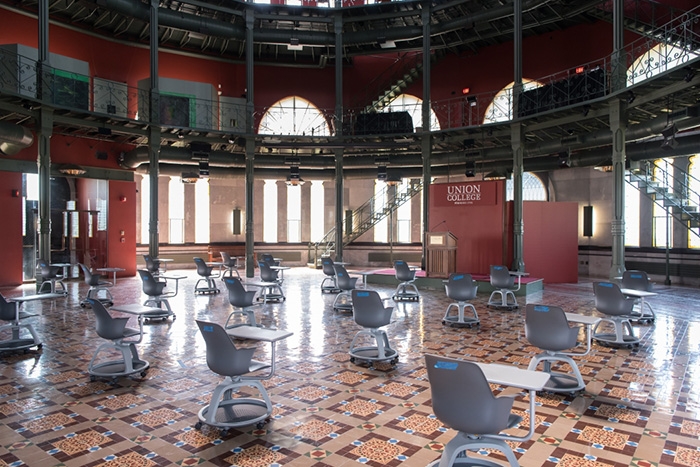The Nott Memorial, Union’s marvelous feat of High Victorian Gothic, has served a variety of roles in its colorful history.
Opened in 1877, the 16-sided treasure has hosted a museum, a library, a bookstore and a theater. It has been used for lectures, conferences, readings, special events, and exhibits in the Mandeville Gallery and Wikoff Student Gallery.
Now, during the COVID-19 pandemic, add classroom to the list.
With the College scouting for alternate spaces to host classes that could meet social distancing guidelines, the Nott was a natural. Space on the first floor of the cavernous structure is flexible and already equipped with digital capability, so little needed to be done to create a classroom with seating for around 30 students. Facilities staff removed mobile tablet arm chairs from classrooms in Lippman Hall for social distancing and placed them in the Nott.
“It was relatively easy,” said Loren Rucinski, director of Facilities. “It was also great to be able to use the chairs from Lippman elsewhere instead of just storing them in the warehouse.”
Other spaces on campus pressed into service to host classes this fall include Memorial Chapel and College Park Hall. Two outdoor tents have also been added as classroom space.
Andrew Morris, associate professor of history, was intrigued by the opportunity to teach in the Nott. The domed building, 89 feet in diameter and 108 feet high, poses some challenges in terms of acoustics. However, Morris and Mike Ulrich of Learning Environments experimented with different technological setups to improve the sound.
“I am excited to be in the Nott,” Morris said. “Given all the challenges and adjustments that face us all, especially the students, this fall, I thought it would be a small silver lining for them to have a class in a place that is different and special and distinctly Union.”
The centerpiece of campus, the Nott is one of America’s most distinctive examples of High Victorian Gothic architecture. In the 19th century, Eliphalet Nott was Union’s president for 62 years, the longest tenure of any American college president.
From the time it was built, the uniquely shaped building struggled to find its identity. For long stretches, College officials were not quite sure what to do with the Nott, using it in a number of ways. There was even talk of demolishing it.
After falling into disrepair, the Nott underwent an extensive multi-million dollar renovation that was completed in time for the College’s bicentennial in 1995.
“We look at this building and we learn from it,” noted historian David McCullough said at the rededication ceremony in 1995. “In a country and in a culture that is becoming increasingly the same, where every airport looks the same, where every bottle of ketchup, every sitcom, and every magazine rack looks the same – how much more important it is to come into a structure where the idea is not to look like anything else.”
Listed on the National Register of Historic Places and the National Historic Landmarks, the Nott stands as the soul of the campus. It is only fitting that, 143 years after it opened, it will host a classroom for the first time in its history.
“The Nott has served, with varied effectiveness, dozens of purposes, but never before a college's most basic function,” said Wayne Somers ’61, editor of the “Encyclopedia of Union College History.”
“Creating a classroom in the space where students held dances 130 years ago will be a worthy experiment because the instructor's need to compete with the intricate aesthetic allure that has always been the Nott's interior glory could spur some inspired teaching.”
